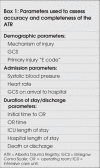Evaluation of a regional trauma registry
- PMID: 17568493
- PMCID: PMC2384278
Evaluation of a regional trauma registry
Abstract
Background: For decades, trauma registries have been the primary source of data for resource allocation, quality improvement efforts and hypothesis-generating research in trauma care. Surprisingly, the quality and completion of data in these registries has rarely been reported. In preparation for a research program on population-based epidemiology of severe trauma, we evaluated the Calgary component of the Alberta Trauma Registry (ATR).
Methods: We identified the ATR records of all adult trauma patients (aged > or = 16 yr) admitted to hospitals in the Calgary Health Region (CRH) between April 1, 2001 and March 31, 2002 with severe injuries (Injury Severity Score > or = 12). From these registry data, we randomly selected 100 patient records, and we compared 14 fields, sampling parameters from prehospital care to discharge, with information from the hospital chart.
Results: Only 9 of 100 records were found to be incomplete. Of these, none had more than 1 field incomplete. Of the approximately 1400 data fields assessed, only 9 were missing data, resulting in a 99% (1391/1400) completion rate. Of 100 records, 22 were found to have inaccurate data; of these, 18 had 1 incorrect field, 2 had 2 incorrect fields and 2 had 3 incorrect fields. Overall, the ATR is 98% accurate.
Conclusions: The Calgary component of the ATR can be considered accurate and complete. Some of its inaccuracy is attributable to a change in the way time to operating room was recorded. Data from all other fields collected in a standard manner can continue to be used with confidence for administrative and research purposes.
Contexte: Pendant des décennies, les registres des traumatismes ont constitué la principale source de données pour l'affectation des ressources, les efforts d'amélioration de la qualité et la recherche génératrice d'hypothèses en traumatologie. La qualité et l'intégralité des données de ces registres ont rarement fait l'objet de rapports, ce qui est étonnant. Pour préparer un programme de recherche en épidémiologie représentative des traumatismes graves, nous avons évalué la partie de Calgary du Registre des traumatismes de l'Alberta (RTA).
Méthodes: Nous avons repéré les enregistrements du RTA portant sur tous les patients adultes traumatisés (âgés de plus de 16 ans) admis dans les hôpitaux de la région sanitaire de Calgary (RSC) entre le 1er avril 2001 et le 31 mars 2002 atteints de traumatismes sévères (indice de gravité de la blessure > 12). À partir de ces données tirées du registre, nous avons choisi au hasard 100 dossiers de patients et nous avons comparé 14 champs, en échantillonnant divers paramètres, des soins préhospitaliers au congé, ainsi que de l'information tirée du dossier de l'hôpital.
Résultats: On a constaté que 9 dossiers sur 100 seulement étaient incomplets. Sur ce total, aucun ne comptait plus d'un champ incomplet. Sur les quelque 1400 champs de données évaluées, il manquait des données dans 9 seulement, ce qui représente un taux d'intégralité de 99 % (1391/1400). Sur 100 enregistrements, on a constaté que 22 contenaient des données inexactes. De ce total, 18 contenaient un champ incorrect, deux en contenaient deux et deux en contenaient trois. Dans l'ensemble, le RTA est exact à 98 %.
Conclusions: La partie de Calgary du RTA peut être considérée comme exacte et complète. Une partie de son manque d'exactitude est attribuable à un changement de la façon de consigner le temps écoulé jusqu'à la salle d'opération. On peut continuer d'utiliser avec confiance, pour les besoins de l'administration et de la recherche, les données tirées de tous les autres champs consignés et recueillis de façon normalisée.
Similar articles
-
Paying the price of excluding patients from a trauma registry.J Trauma. 2006 Feb;60(2):300-4. doi: 10.1097/01.ta.0000197393.64678.6b. J Trauma. 2006. PMID: 16508486
-
The value of trauma registries.Injury. 2008 Jun;39(6):686-95. doi: 10.1016/j.injury.2008.02.023. Injury. 2008. PMID: 18511052 Review.
-
Trauma registry data validation: Essential for quality trauma care.J Trauma. 2006 Dec;61(6):1400-7. doi: 10.1097/01.ta.0000195732.64475.87. J Trauma. 2006. PMID: 17159683
-
Application of electronic surveillance and global information system mapping to track the epidemiology of pediatric pedestrian injury.J Trauma. 2009 Mar;66(3 Suppl):S10-6. doi: 10.1097/TA.0b013e3181937bc8. J Trauma. 2009. PMID: 19276720
-
Pediatric disaster preparedness: the potential role of the trauma registry.J Trauma. 2009 Aug;67(2 Suppl):S172-8. doi: 10.1097/TA.0b013e3181af0aeb. J Trauma. 2009. PMID: 19667854 Review.
Cited by
-
Eye Injury Registries: A Review on Key Registry Processes.Iran J Public Health. 2021 Dec;50(12):2495-2508. doi: 10.18502/ijph.v50i12.7922. Iran J Public Health. 2021. PMID: 36317027 Free PMC article. Review.
-
Trauma registry record linkage: methodological approach to benefit from complementary data using the example of the German Pelvic Injury Register and the TraumaRegister DGU(®).BMC Med Res Methodol. 2013 Mar 5;13:30. doi: 10.1186/1471-2288-13-30. BMC Med Res Methodol. 2013. PMID: 23496832 Free PMC article.
-
A review of injury epidemiology in the UK and Europe: some methodological considerations in constructing rates.BMC Public Health. 2009 Jul 10;9:226. doi: 10.1186/1471-2458-9-226. BMC Public Health. 2009. PMID: 19591670 Free PMC article. Review.
-
The evolution of trauma surgery at a high-volume Canadian centre: implications for public health, prevention, clinical care, education and recruitment.Can J Surg. 2015 Feb;58(1):19-23. doi: 10.1503/cjs.001314. Can J Surg. 2015. PMID: 25427332 Free PMC article.
-
Trauma patients without a trauma diagnosis: the data gap at a level one trauma center.J Trauma. 2009 Oct;67(4):822-8. doi: 10.1097/TA.0b013e31818c1583. J Trauma. 2009. PMID: 19820591 Free PMC article.
References
-
- Howard JM. Historical background to accidental death and disability: the neglected disease of modern society. Prehosp Emerg Care 2000;4:285-9. - PubMed
-
- Pollock DA, McClain PW. Trauma registries: current status and future prospects. JAMA 1989;262:2280-3. - PubMed
-
- Stone DH. A method for the validation of data in a register. Public Health 1986;100:316-24. - PubMed
-
- Morrison W, Wright JL, Paidas CN. Pediatric trauma systems. Crit Care Med 2002;30:S448-S456. - PubMed
MeSH terms
LinkOut - more resources
Full Text Sources
Medical
Miscellaneous

